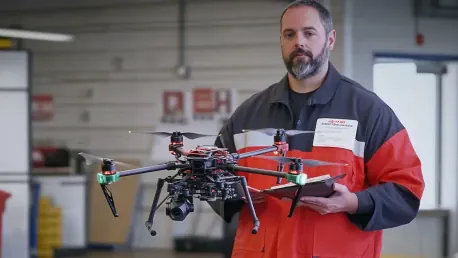In an era where drones play an increasingly pivotal role across a spectrum of industries including agriculture, law enforcement, entertainment, and disaster response, ensuring their safe operation is critical. Recognizing this necessity, NASA has developed an advanced safety management system known as the In-Time Aviation Safety Management System (IASMS). This groundbreaking system is designed to predict and mitigate airborne risks in real-time, proactively ensuring drone operations remain safe and efficient.
Real-Time Risk Management for Drone Operations
The IASMS represents a significant advancement in the safety management of drones by continuously monitoring, assessing, and alleviating potential hazards before they even occur. Its primary objective is to provide real-time alerts to drone operators during unusual situations such as loss of navigation or communication. This proactive approach allows for a more safety-conscious environment, reducing the risks associated with the increasing use of drones in critical sectors.
Comprehensive Simulations and Flight Tests
NASA’s dedication to refining IASMS involved extensive simulations and drone flight tests aimed at examining the system’s efficiency and integration of critical components. One notable simulation took place at NASA’s Ames Research Center in California. During this exercise, twelve drone pilots were tasked with managing supply drops to hurricane-stranded residents, a scenario designed to extract data on pilot performance, mission success, workload, and system usability. The complexity of this simulation was enhanced with background operations such as search and rescue missions and levee inspections, providing a comprehensive evaluation of the system’s functionality.
The gathered data from these simulations were integral in understanding the practical applications of IASMS. The feedback from drone pilots highlighted the system’s capability to simplify operations by reducing the cognitive load on operators, allowing them to focus more on their primary mission. The real-time alerts and risk assessments provided by IASMS proved crucial in enhancing the decision-making processes, thereby improving operational safety and efficiency.
To further validate the system, additional flight tests are planned for 2027, incorporating insights and improvements derived from previous simulations. These continuous evaluations underscore NASA’s commitment to advancing drone safety management technology to meet the growing demands of the industry.
Collaboration and Research Efforts
Collaborative efforts played a vital role in advancing IASMS, as seen in the summer of 2024, when NASA partnered with the Ohio Department of Transportation and teams from The George Washington University, the University of Notre Dame, and Virginia Commonwealth University. This partnership led to a series of drone flights conducted across various locations, with diverse mission scenarios and hazards tailored to evaluate IASMS’s adaptability to different operational contexts.
The collaborative tests involved applications such as wildfire surveillance and urban package delivery, each presenting unique challenges that the IASMS had to navigate. These varied scenarios ensured the system’s robustness and resilience, confirming its readiness to handle real-world situations. The feedback from these collaborative efforts provided critical insights into the practical aspects of the system’s functionality, contributing to its continual refinement and enhancement.
During wildfire surveillance tests, the system was able to detect potential hazards and provide timely alerts, enabling operators to take preemptive actions. In urban package delivery scenarios, the IASMS helped navigate the complexities of urban environments, ensuring that drones maintained their course and avoided obstacles. This ability to adapt to diverse situations reinforced the system’s value as a comprehensive safety solution.
Integration with Unmanned Aircraft System Traffic Management
NASA’s vision for the future of drone operations involves integrating IASMS with the Unmanned Aircraft System Traffic Management (UTM), aiming to standardize routine drone flights across the United States. The integration of these systems will add an extra layer of safety, ensuring reliable airspace management over populated areas. This harmonization is crucial in fostering trust and reliability in drone operations, which is essential for their widespread adoption in various critical sectors.
Collaborative Efforts for Enhanced Safety
The successful implementation of IASMS requires the collaborative efforts of multiple stakeholders, including drone operators, manufacturers, operating companies, and the Federal Aviation Administration (FAA). Michael Vincent of NASA emphasized the importance of this collaboration, stating that real-time risk monitoring and mitigation significantly enhance the security of drone operations in national airspace. By fostering a culture of safety and collaboration, NASA aims to create a safe and efficient environment for the integration of drones into everyday activities.
The ongoing collaboration with the FAA and other stakeholders ensures that the system aligns with regulatory requirements, making it a reliable tool for drone operators. This partnership not only enhances the safety of drone operations but also promotes innovation by creating a framework where new technologies can be tested and integrated seamlessly.
Future Considerations and Technological Advancements
NASA’s System-Wide Safety project, under the Airspace Operations and Safety program, continues to spearhead these initiatives. This program is part of the broader Advanced Air Mobility mission, which aims to provide critical data guiding the development of electric air taxis and drones. Through meticulous experimentation and collaboration, NASA’s advancements in drone safety management are poised to revolutionize how drones integrate into daily life while maintaining stringent safety standards.
Future efforts will focus on leveraging emerging technologies, such as artificial intelligence and machine learning, to further enhance the IASMS’s predictive capabilities. By analyzing vast amounts of data in real-time, these technologies can provide even more accurate risk assessments and timely alerts, ensuring the highest level of safety for drone operations.
The continuous development of IASMS reflects NASA’s commitment to innovation and safety. As the system evolves, it will serve as a model for other safety management systems, setting a benchmark for the industry. This forward-looking approach ensures that NASA remains at the forefront of drone technology, driving progress and fostering a safer, more efficient future for drone operations.
Conclusion
In a time when drones are becoming a crucial part of numerous industries such as agriculture, law enforcement, entertainment, and disaster response, ensuring their safe operation is more important than ever. To address this critical need, NASA has developed an advanced safety management system called the In-Time Aviation Safety Management System (IASMS). This innovative system is specifically designed to anticipate and reduce airborne risks in real-time, helping to ensure that drone operations are not only safe but also efficient. By proactively identifying potential dangers, the IASMS allows for immediate corrective actions, thereby minimizing accidents and optimizing performance. This cutting-edge solution is vital in modernizing how drone activities are managed and supervised, significantly enhancing the reliability and safety of using drones in various essential sectors. With the implementation of IASMS, industries that rely on drones can expect a significant boost in operational safety and effectiveness.









